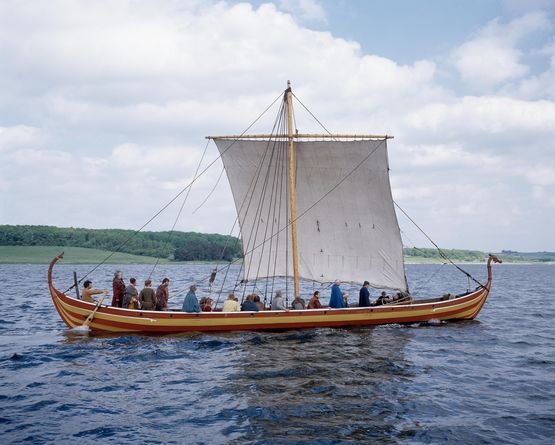
Royal power and society
Up through Viking times, the constituent parts of the Danish kingdom came together. As early as in written sources from the Frankish Empire to the south we have names for the Danish kings, but whether they ruled over the whole of the area we today call Denmark, or just smaller parts of it, is not known. With Gorm the Old began the Jelling Dynasty, and after this there are no more gaps in the list of royal succession. Gorm the Old died in about AD 958 and his son Harald Bluetooth became king. There is uncertainty about whether Gorm ruled over the whole of Denmark or just Jutland. But on his death, Harald Bluetooth writes on the great Jelling stone, also known as Denmark's birth certificate, that he: "won for himself all of Denmark and Norway and made the Danes Christian".
- Why is Denmark called Denmark? Look for answers in the library or on the Internet.
- How would you describe the difference between the power of a chieftain, a king and a state?
- How was Viking society organised?
- Discuss the difference between our society today and in Viking times.
- Write a story about how you think life was in Viking times. Organise your story so that you can tell it from different angles. Perhaps as a thrall/slave, as a farmer, as a merchant, as a warrior, as a clergyman or as a king.
- Draw a Viking king: Consider how you could make it plain that he was an important, wealthy and powerful man.
As early as the 8th century, work began on the great fortification bank called Dannevirke, the remains of which lie today about 40 km south of the Danish-German border. Up through Viking times this was built larger and larger and under Harald Bluetooth the famous ring forts were built; these were enormous fortifications for their time.
Dannevirke and the ring forts, together with the other fortifications for example those around the towns, are all indications of an increasingly stronger royal power that wished to defend the kingdom.
- Draw a ring fort.
- Who built the ring forts and Dannevirke?
- Why was Dannevirke built?
- What was the construction of the ring forts?
- How did people fortify their towns?
- How was Roskilde defended in the 11th century?
- Describe the dynastic strife in Denmark in the middle of the 11th century, when Harald Hardrada ravaged Denmark. Are the Skuldelev barrages associated with these events?
Urban development and royal power were closely linked. In Viking times, many new towns were founded in Scandinavia. They became centres for trade, royal administration and the newly established Christianity. In the towns, the kings activities including the minting of coins, the collection of tolls and taxes and the assembling of their leding (army).
- What role did Viking Age towns play for the royal power, for the church and for the development of society?
- Discuss the consequences for Danish society of increased contact with foreign merchants and wares.
- Why was the minting of coins so important for royal power?
- Why were Arabic or Frankish coins copied?
- Compare a modern coin with a Viking example. What similarities and differences are there?
- How was the value of a Viking coin determined?
- Is there a difference in the way that coins were used at the start of the Viking period and at the end?
- Investigate images of coins from Viking times and design your own coin. Explain your design.
- Make a leather purse.
Tools
- Pung ENG.pdf
- Make a leather purse.